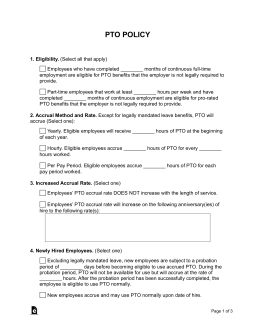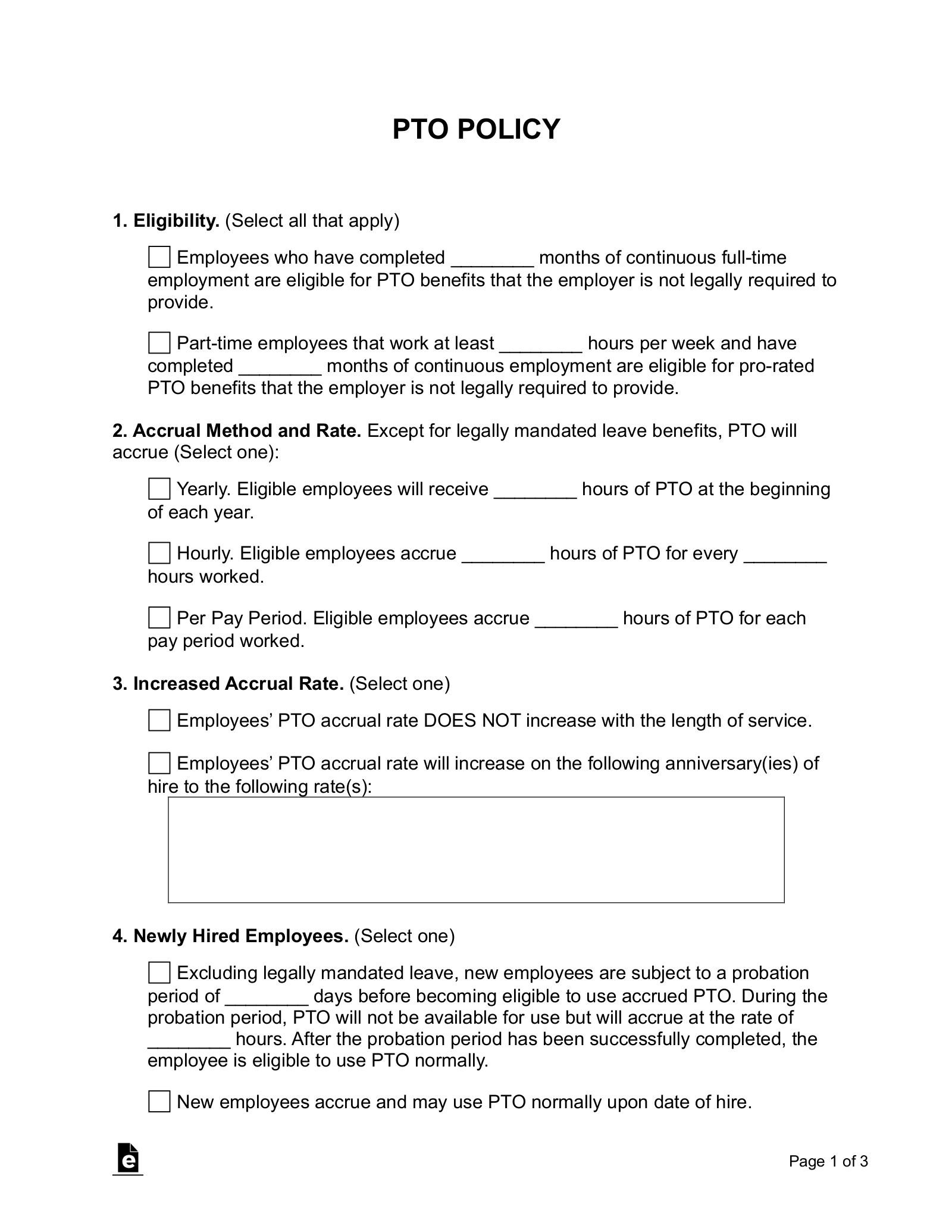Updated February 13, 2024
A Paid Time Off (PTO) Policy is a set of rules adopted by a company that defines when and how an employee may take time off from work while still getting paid. PTO policies are used in place of traditional vacation and sick leave policies by “bundling” employees’ time off, giving them the freedom to choose how their time is used.
Paid or Unpaid
Some employees may not qualify for certain paid benefits, depending upon a company’s PTO policy. Regardless, these employees are still entitled to any paid or unpaid leave that is mandated by state and federal law.
Table of Contents |
PTO Requirements
State and federal laws grant employees the right to take unpaid time off for family leave and/or illness. Numerous state and local laws require that employers offer paid time off for sick and family leave under certain circumstances. If an employer does offer PTO benefits, some states have laws in place that regulate some aspects of the PTO policy.
For example, some states require that employees are compensated for any unused PTO when they separate from employment. Other states set minimum accrual standards.
Exceptions
Employers that engage in government contract work falling under the McNamara O’Hara Service Contract Act (SCA) or Davis-Bacon and Related Acts (DBRA) may need to offer PTO. These laws require adherence to the same wages and fringe benefits found to prevail within the locality. If PTO is the standard, then PTO needs to be offered.[1][2]
Uses
Because PTO “bundles” the various types of paid time off into a single total, employees can use it as desired. The benefit to the employee is that paid time off can be used instead of time off that would otherwise not be paid. Uses can include:
- Vacation
- Personal Time
- Illness
- Family Leave
- Bereavement
- Jury Duty
Each policy will have its own terms and restrictions regarding accrual and use.
Types of Policies
The primary difference between types of PTO policies is the method by which time is accrued. When determining the accrual method, two questions are being asked: “How often?” and “How much?”
Per Pay Period
With this type of policy, the employee earns a small amount of PTO at the end of each pay period which accrues into a usable quantity over time.
Hourly
An hourly accrual method is similar to the pay period accrual method. With an hourly arrangement, the PTO is given after a set number of work hours is completed by the employee. An employer will give the employee 1.5 hours of PTO for every 30 hours worked, for instance.
Yearly
With this type of policy, a “bank” or “lump sum” of PTO is given to eligible employees at the beginning of the year, to be used at their discretion. Once it is used, it doesn’t replenish until the beginning of the following year, which is normally based on the employee’s date of hire.
Unlimited
Unlimited PTO is a scenario where employees can take as much time throughout the year as needed. Even though the amount of PTO is at least theoretically unlimited, time off is typically subject to approval by management.
Unlimited PTO policies have their pros and cons. They tend to be far less work for a company to manage because hours and use are not being tracked. On the other hand, depending upon the workplace culture, employees may feel peer pressure to not take time off for fear of letting down their coworkers.
How Much PTO is Normal?
When discussing “bundled” PTO (PTO that includes vacation, sick, family, personal, etc.) this will vary from company to company and differ from one industry to another.
Typical PTO Accrual Rates
In 2022, the average amount of PTO received by employees after 1 year of employment was between 8 and 13 days per year.[3] Using these numbers, the following accrual rates are the average in the United States:
- Pay Period: 2.5 to 4 hours per pay period (2-week pay period)
- Hourly: 1.25 to 2 hours per 30 hours worked (30-hour work week)
- Yearly: 8 to 13 days per year
For details about variations based on industry type, refer to this Stacker.com article discussing typical PTO accrual rates by industry.
Accrual Rate Increases Over Time
Some companies reward employees for length of service by increasing their PTO at certain anniversaries of their hire date. An employer may give more PTO to an employee after they have been with the company for 3, 5, and 10 years, for example.
Frequently Asked Questions
Does PTO have to be paid out when an employee leaves the company?
This varies from state to state. Some states allow unused PTO to become forfeit when the employee separates from employment. Others require employers to compensate employees for unused PTO at the time of separation, regardless of the reason for separation. The State Laws Regulating Paid Time Off section below offers specific details.
What is “use-it-or-lose-it,” and is it legal?
Some PTO policies specify that unused PTO disappears at the end of each year. The legality of this practice varies by state. The State Laws Regulating Paid Time Off section below offers specific details.
What are blackout dates, and are they legal?
Some companies experience seasonal increases in workload. It can be disruptive to the business if employees take leave during such times. To avoid any issues during a busy time, a company may prohibit PTO use during certain parts of the year. Except in cases of sick or family leave, it is perfectly legal for a company to regulate PTO use in this manner.
How do I request PTO?
A comprehensive PTO policy should have clear instructions detailing how employees are expected to make requests. Normally, requests must be made some time in advance of a planned absence. However, these rules will not apply to sick or family leave. If an employee is uncertain about how to make a request, their direct Supervisor or Human Resources contact should be able to help.
State Laws
A number of states require that employers adhere to the terms of any policies that they establish. This means that if a PTO policy promises to pay out an employee’s unused PTO upon separation, then the employer must pay the employee for unused PTO even if state law does not require it.
Best Practice: Employers should honor the terms of their PTO policies. If changes to an existing policy are to be implemented, sufficient and proper notice must be given to employees.
States That Prohibit “Use-it-or-Lose-it”
While the following few states expressly prohibit “use-it-or-lose-it” terms in a PTO policy, several other states have laws that place limitations on their use and enforcement.
- California
- Maine
- Montana
- Nebraska
States That Require Payout
The following states expressly require that employers payout any unused PTO benefits to the employee upon separation.
- California
- Colorado
- Connecticut
- Illinois
- Indiana
- Kansas
- Kentucky (only if employer offers “vested vacation pay”)
- Louisiana
- Maine
- Massachusetts
- Nebraska
- North Carolina
- North Dakota
- Rhode Island
- Washington D.C.
- Wyoming
A number of states that do not require payout still do regulate if and how employers must compensate employees for unused PTO benefits upon separation. Detailed information about each state’s PTO laws is available at Thomson Reuters’ Vacation Pay State Laws Chart.
In the absence of state and federal sick leave laws, some US cities have adopted paid sick leave requirements that should be considered when creating a PTO policy. Details about local PTO requirements can be found on the Society for Human Resource Management’s State and Local Paid Sick Leave Chart.
Sample
PTO POLICY
Eligibility. (Select all that apply)
☐ Employees who have completed [#MONTHS] months are eligible for PTO benefits.
☐ Part-time employees that work at least [#HOURS] hours per week and have completed [#MONTHS] months are eligible for pro-rated PTO benefits.
Accrual Method and Rate. PTO will accrue (Select one):
☐ Yearly. Eligible employees will receive [#HOURS] hours of PTO at the beginning of each year.
☐ Hourly. Eligible employees accrue [#HOURS] hours of PTO for every [#HOURS] hours worked.
☐ Per Pay Period. Eligible employees accrue [#HOURS] hours of PTO for each pay period worked.
Increased Accrual Rate. (Select one)
☐ Employees’ PTO accrual rate DOES NOT increase with the length of service.
☐ Employees’ PTO accrual rate will increase on the following anniversary(ies) of hire to the following rate(s): [DETAILS]
Newly Hired Employees. (Select one)
☐ New employees are subject to a probation period of [#DAYS] days before becoming eligible to use accrued PTO. During the probation period, PTO will not be available for use but will accrue at the rate of [#HOURS] hours.
☐ New employees accrue and may use PTO normally upon date of hire.
Use. PTO may be used for (select all that apply):
☐ Vacation
☐ Sickness
☐ Bereavement
☐ Personal Time; and other reasons approved by management.
To use PTO, employees must submit a request to their supervisor or manager [#WEEKS] weeks in advance of the requested time off, except in cases of emergency.
Seasonal Restrictions and Blackout Dates. (Select one)
☐ Seasonal Restrictions: At management’s discretion, based on workload and availability of coverage, PTO requests may not be approved if the request includes a day or days that fall on, or within, the dates of: [DATES].
☐ Blackout Dates: PTO requests will not be approved if the request includes a day or days that fall on, or within, the dates of: [DATES]
☐ PTO is not restricted seasonally or by specific dates.
Rollover. (Select one)
☐ Any unused PTO at the end of the year will be carried over to the following year.
☐ Rollover is not permitted. Employees forfeit any unused PTO at the end of the year.
Maximum PTO Accrued. (Select one)
☐ The maximum PTO that an employee may accrue is [#HOURS] hours.
☐ The maximum PTO that an employee may accrue is unlimited.
Payout. (Select one)
☐ Upon separation from employment, employees will receive a payout for accrued and unused PTO.
☐ Unused PTO will not be paid out upon employee’s separation from employment.
Reinstatement. (Select one)
☐ After separation from employment, if the employee is rehired within [#MONTHS] months, unused PTO that was not paid out upon separation, will be reinstated.
☐ Upon separation from employment, employees forfeit any remaining unused PTO benefits.
Other Terms and Conditions. [TERMS AND CONDITIONS] (if any)


